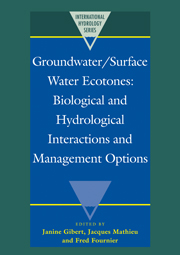Book contents
- Frontmatter
- Contents
- List of authors
- Preface
- I INTRODUCTION
- II FUNCTION OF GROUNDWATER / SURFACE WATER INTERFACES
- III MALFUNCTION OF GROUNDWATER / SURFACE WATER INTERFACES: CAUSES AND METHODS OF EVALUATION
- 19 Heterogeneity of groundwater-surface water ecotones
- 20 Failure of agricultural riparian buffers to protect surface waters from groundwater nitrate contamination
- 21 Stable nitrogen isotope tracing of trophic relations in food webs of river and hyporheic habitats
- 22 La zone hypodermique du sol écotone entre eaux météoriques et eaux souterraines dans l'infiltration des pesticides dissous
- 23 Soils of the north-eastern coast of the Caspian Sea as the zone of sea water/groundwater interaction
- IV MANAGEMENT AND RESTORATION OF GROUNDWATER / SURFACE WATER INTERFACES
- V CONCLUSION
- ANNEX
20 - Failure of agricultural riparian buffers to protect surface waters from groundwater nitrate contamination
Published online by Cambridge University Press: 07 September 2010
- Frontmatter
- Contents
- List of authors
- Preface
- I INTRODUCTION
- II FUNCTION OF GROUNDWATER / SURFACE WATER INTERFACES
- III MALFUNCTION OF GROUNDWATER / SURFACE WATER INTERFACES: CAUSES AND METHODS OF EVALUATION
- 19 Heterogeneity of groundwater-surface water ecotones
- 20 Failure of agricultural riparian buffers to protect surface waters from groundwater nitrate contamination
- 21 Stable nitrogen isotope tracing of trophic relations in food webs of river and hyporheic habitats
- 22 La zone hypodermique du sol écotone entre eaux météoriques et eaux souterraines dans l'infiltration des pesticides dissous
- 23 Soils of the north-eastern coast of the Caspian Sea as the zone of sea water/groundwater interaction
- IV MANAGEMENT AND RESTORATION OF GROUNDWATER / SURFACE WATER INTERFACES
- V CONCLUSION
- ANNEX
Summary
ABSTRACT For two years we studied the flux of nitrogen moving in shallow groundwater from double row-cropped uplands through a flood plain and into a second order stream in Maryland. Two floodplain sites were compared: one forested and the other vegetated by grass. At both sites, the soil layer through which the groundwater moved was very sandy. The nitrate concentrations leaving the crop fields were 20–30 mg N1−1 and averaged 25 mg N−1. Nitrate concentrations declined about 32% on average from the field edge to 48 m into the forest and this decrease was about 44% on average in the grassed buffer. These decreases were greater in the winter than in the summer. Nitrate to chloride ratios declined about 43% across the riparian forest transect. Declines in nitrate concentration were not accompanied by offsetting increases in dissolved organic N or ammonium. Soil Eh averaged 191 mV and 263 mV at 33 m and 48 m into the forest, respectively. While nitrate removal rates were the highest of three study sites we have investigated in the Maryland Coastal Plain, nitrate concentrations entering the stream channel were still high (12–18 mg N−1). The flux of nitrate in groundwater from the farm fields at this site clearly exceeded the nitrate removal capacity of these riparian buffers.
INTRODUCTION
Coastal receiving waters are often overenriched with nutrients, especially in cases where the drainage basins are intensively farmed or support large populations of humans (Beaulac & Reckow, 1982; Turner & Rabalais, 1991).
- Type
- Chapter
- Information
- Groundwater/Surface Water EcotonesBiological and Hydrological Interactions and Management Options, pp. 162 - 165Publisher: Cambridge University PressPrint publication year: 1997
- 15
- Cited by

